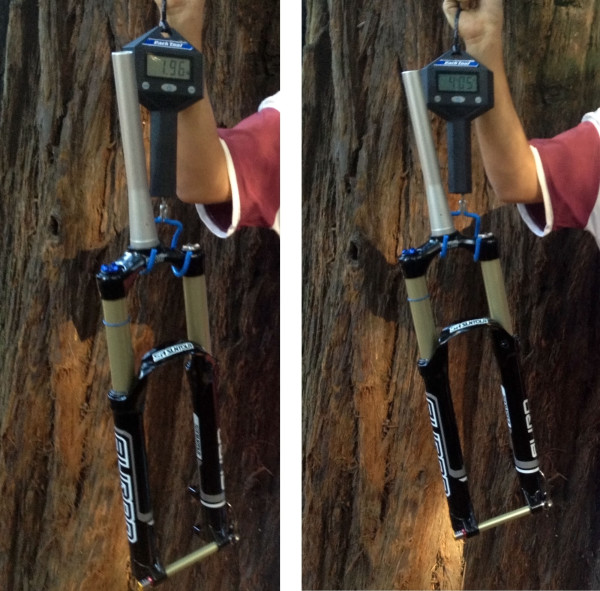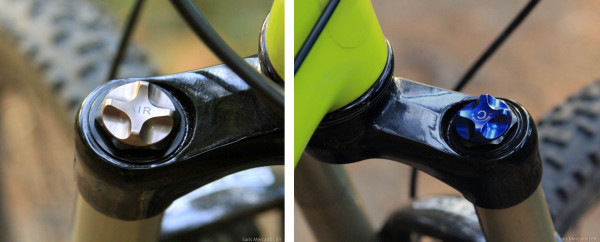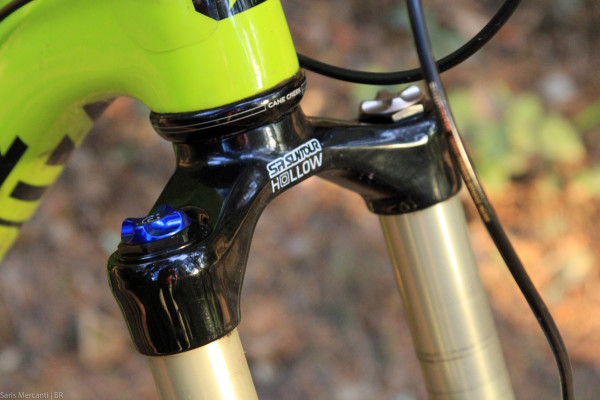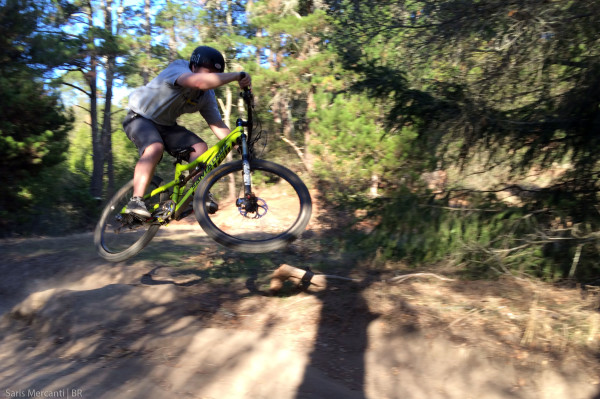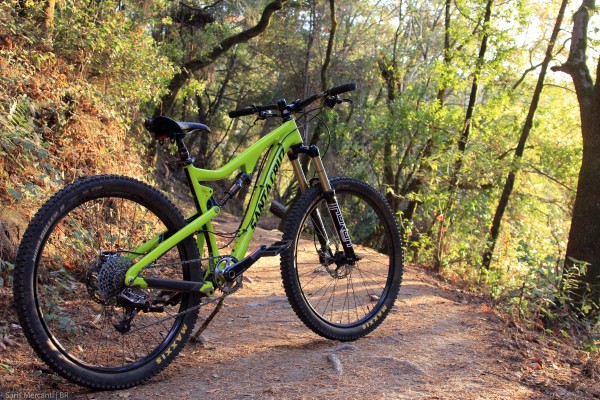 Cycling is an expensive sport and few components are as important to the feel of full suspension mountain bike as the front fork, so we’re always eager to test new products that promise to save of us some cash without sacrificing performance.
Cycling is an expensive sport and few components are as important to the feel of full suspension mountain bike as the front fork, so we’re always eager to test new products that promise to save of us some cash without sacrificing performance.
The new Auron fork is Suntour’s premium offering in the burgeoning 150/160mm 650b trail/race/enduro market. It’s reasonably priced, weighs less than some of the ultra premium offerings by competitors, and there’s even an option with both high and low speed compression, so how does it perform on the trails?
Weight 
On our Park Tools scale, the Suntour Auron weighed in at 1.96 kg or 4.05 lbs without the steer-tube shortened. This scale shot is in both kilograms and pounds, because we love our non-‘Murican readers.
Tech
The Suntour Auron in available in four different iterations. The entry level model of the air fork offers only rebound adjustments, the RL version we tested ($650) has both rebound and low speed compression knobs, and the premium RC2 offering ($700) gives riders the ability to tune both rebound and high and low speed compression.
An additional travel adjust model, the TA-RC2 ($800), is also available. This model has low and high spreed compression, rebound adjustment, and can be switched on the fly between 160-120mm of travel.
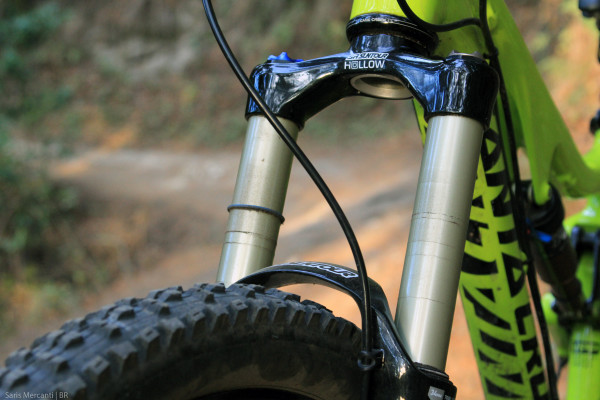 Hollow forged magnesium crowns help keep the weight down
Hollow forged magnesium crowns help keep the weight down
Suntour uses a pretty standard suspension configuration, with with one leg housing the air system, and the other a closed cartridge which handles damping duties. Whats special is that all Suntour forks use grease rather than oil to lubricate the internals. The advantage to this is apparent when it comes service time. The lack of oil means you can easily adjust the travel, make quick tuning changes, etc.. in just a few minutes. No mess, no fuss. We see this as a huge advantage for racers on forks like the Rux DH, which has an air chamber that can be easily tuned with spacers in minutes.
The only potential downside noticed is that this fork did have a tendency to weep more than comparable products. After each ride, the dust that built up on the stanchions tended to cake thickly around the seals and needed to be cleaned. That said, the fork still feels smooth after months of riding, so the seals seem to be performing their job.
Suntour recommends that the lowers be cleaned and relubed after every 50 hours and that a full cartridge rebuild be performed after every 100 hrs. The full cartridge rebuild consists mainly of draining the old oil and adding fresh lubricant. At the factory, the high grade felt oil wipers are soaked in a light oil bath for least 30 minutes before being installed (which is also recommended you do during rebuilds) and then grease (they use Slickolieum…which is a favorite of ours as well) be applies on the bushings and dust wipers. Additionally, riders can add up to 20cc of oil in the lowers for splash lubrication. If you choose to go this route, Suntour recommends using lighter weight oils, such as 0W fully synthetic.
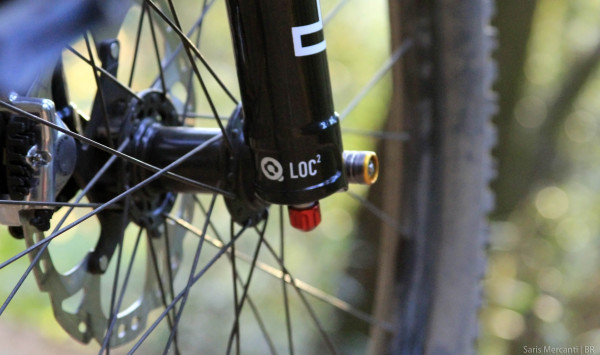
Look towards the bottom of the fork and you’ll find the rebound knob in it’s standard position and post mount disc brake mounts.
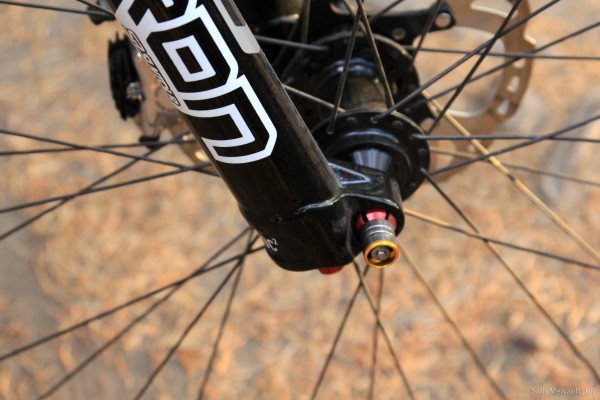 Holding the axle in place is Suntour’s propreitary Q-Loc2 system, which is essentially a spring loaded collet. The red collet expands to prevent the axle from being released and turning the silver barrel allows you to adjust tension.
Holding the axle in place is Suntour’s propreitary Q-Loc2 system, which is essentially a spring loaded collet. The red collet expands to prevent the axle from being released and turning the silver barrel allows you to adjust tension.
This one of the simplest axles to use on the market, all though we did have some issues removing the wheel after riding in muddy conditions. When we tried to remove the wheel, we had some difficulty getting the collet to collapse down enough to pull through the hub. It wasn’t till we hosed down and lubed the mechanism in order to remove any latent dirt particles that we were able to easily remove the wheel.
Set-Up
This fork has been installed on two different high end mountain bikes for testing – the Rocky Mountain 790 MSL and a Santa Cruz Bronson. I put at least a hundred miles on this fork before passing it off to one of our local test riders for further testing, and he has since put a a few hundred miles on the fork. What is interesting is that despite not sharing notes, in order to avoid biasing each other, we came to very similar conclusions about the initial setup and performance of the fork.
We initially set the fork to roughly 20% sag, with minimal low speed compression. With this amount of sag, the fork felt very linear and smooth cruising the parking lot, but could easily be bottomed out by pushing down sharply. Adding clicks of low speed compression did seem to have some impact on the mid-stroke ramp up, but it made the fork feel less supple off the top, and did not mitigate the bottom out issue.
So we tried to find the sweet by reducing the low speed compression clicks by a few clicks, and increasing the volume of air until we had roughly 10% sag. This gave the fork a nice progressive feel under aggressive trail maneuvers, where suspension performance matters most, but had the adverse affect of sacrificing plushness at the top of stroke.
On the Trail
As suspensions performance is best tested on the trails, not the the bike path, we hit our share of favorite after work loops, trail networks, and even some burly shuttle laps. Out here, that little extra time we spent figuring out how to dial in the Auron really paid off. Particularly when shuttling, where we could test different combinations of sag versus compression, it was very apparent that this is a fork that likes to be aired up.
Set it up with your standard ~20% sag and the fork has a tendency to eat through its travel. If you’re adventurous, you can remove the air spring and trim the elastomer volume reducer to get a more progressive linear tune (a modification that can’t be undone), but we chose to review the fork in it’s stock configuration. To make the fork more progressive Suntour suggests adding between 5-10cc of a 5-10 weight oil. Despite the lack of ramp up, lighter and less aggressive riders will be impressed by the smooth stictionless feel of the Auron. Even when hitting small to medium size drops, the bottom was not harsh.
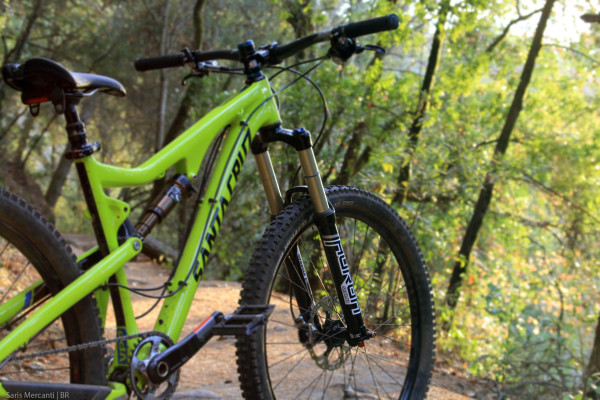
When jamming down trails with big hits and rougher terrain, adding that extra PSI made a huge difference in performance. The stiff initial feel didn’t soak up the little hits, which did cause unnecessary arm and hand fatigue, but it did a more than adequate job of smoothing out rocks and roots. On shuttle days, places a150mm travel bike would have been considered out gunned a few years ago, the big hits had a tendency to bottom the fork out unless we were either ultra smooth or ran essentially no sag and dialed up the compression, but again – it didn’t suffer from excessive diving under hard braking or cornering and took bottom out situations really well.
After reaching out to Suntour about the fork, we were told that the travel adjust model has a more progressive tune than the RC model we tested. We were also told that they have now switched to a softer hi speed compression spring inside the cartridge, which will allow for a wider range of adjustment on the high and low speed compression settings.
While we give Suntour high marks for improving the adjustability of the fork, it didn’t do anything to mitigate our one major annoyance on the trail…the noise. In an era where modern bikes are whisper quiet, the Auron is jarringly loud. It’s so bad in fact your buddies might develop a running joke about its “mating call.” As soon as we installed the fork, we noticed it was louder than anything we’ve tested before. When rebounding, it would make a loud whooshing noise which bad annoying but bearable, but the noise quickly escalated to a high pitched squeal wooshing noise clamor (I don’t really know how to describe it, sorry) when the fork was rebounding quickly. According to Suntour, this is due to the rebound shim/shaft orifice sticking and does not negatively affect the performance of the fork, and can be fixed by doing a simple cartridge rebuild.
Aside from a few small annoyances, the Auron is a really nice quality product. Considering it retails for nearly half of what the other major players go for, it’s really hard to find anything to dislike. We wholeheartedly believe that someone with the knowledge, patience, and skill could rip the cartridge apart and tune this fork to perform flawlessly. Out of the box though, the RC fork, with it’s lack of high speed compression damping left something to be desired. The current tune will work well for novice riders purchasing this fork as an entry level because of it’s supple feel, and aggressive riders on a budget will be happy to sacrifice suppleness at the top of the stroke for the forks great performance on high speed descents.
